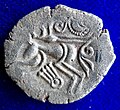Stater
The stater (. The term is also used for similar coins, imitating Greek staters, minted elsewhere in ancient Europe.
History
The stater, as a Greek silver currency, first as ingots, and later as coins, circulated from the 8th century BC to AD 50. The earliest known stamped stater (having the mark of some authority in the form of a picture or words) is an
The silver stater minted at
and more.There also existed a "gold stater", but it was only minted in some places, and was mainly an accounting unit worth 20–28 drachmae depending on place and time, the Athenian unit being worth 20 drachmae. (The reason being that one gold stater generally weighed roughly 8.5 g (0.27 ozt), twice as much as a drachma, while the parity of gold to silver, after some variance, was established as 1:10). The use of gold staters in coinage seems mostly of
Non-Greek staters

Celtic staters were also minted in present-day Czech Republic and Poland.[11] The conquests of Alexander extended Greek culture east, leading to the adoption of staters in Asia. Gold staters have also been found from the ancient region of Gandhara from the time of Kanishka.[12]
In 2018, archaeologists in Podzemelj, Slovenia unearthed fifteen graves at the Pezdirčeva Njiva site. In one of the graves they found a bronze belt with a gold coin. The coin was a
Gallery
-
Qoppa (Ϙ) beneath. Reverse: Athenawearing Corinthian helmet. Qoppa symbolised the archaic spelling of the city (Ϙόρινθος).
-
Gold stater of Alexander the Great. Obverse: Athena wearing Corinthian helmet. Reverse: Nike holding stylis and wreath. Possibly minted in Abydos c. 328–323 BC.
-
Stater struck inLiondevouring prey
-
Silver stater of Mithrapata of Lycia, c. 390–370 BC
-
Gold stater of the Corieltauvi, 50−20 BC
-
Channel Islands Armorican Billon Silver Stater about 75 BC, obverse, head r.
-
The reverse showing a stylised horse r., and a comet below
See also
- Coson
- Egyptian gold stater
- Silver stater with a turtle
- Esunertos
References
- ^ "stater". Merriam-Webster.com Dictionary. Merriam-Webster.
- ^ Coin images
- ^ Ancient coinage of Aegina. snible.org. Retrieved on 2011-02-10.
- ISBN 978-0-7139-9980-8
- ^ Smith, William. A Dictionary of Greek and Roman Antiquities. J. Murray, 1881.
- ^ Catalogue of Greek coins, A. Baldwin, Boston, 1955
- ^ ISBN 0-7478-0325-0.
- ISBN 0-7478-0325-0.
- ISBN 0-7478-0325-0.
- ^ Bean, Simon C (1994). "Methodology". The coinage of Atrebates and Regni (PDF) (Ph.D.). University of Nottingham. pp. 17–18. Retrieved 14 July 2016.
- ISBN 83-04-00569-7.
- ISBN 978-81-85026-73-2.
- ^ A significant find at Pezdirčeva Njiva: A gold coin from the 3rd century B. C.
External links
 The dictionary definition of stater at Wiktionary
The dictionary definition of stater at Wiktionary- The British Museum- Electrum 1/6 stater (650–600 BCE)
- "Ancient coins: heads and tales from antique lands – Silver stater with Pegasus and head of Athena wearing a Corinthian helmet, Akarnania, (Akarnanian Confederacy) c. 250–167 BCE, Thyrreion mint". Artabase. Archived from the original on Apr 18, 2011.
- Stater coins (review article)









